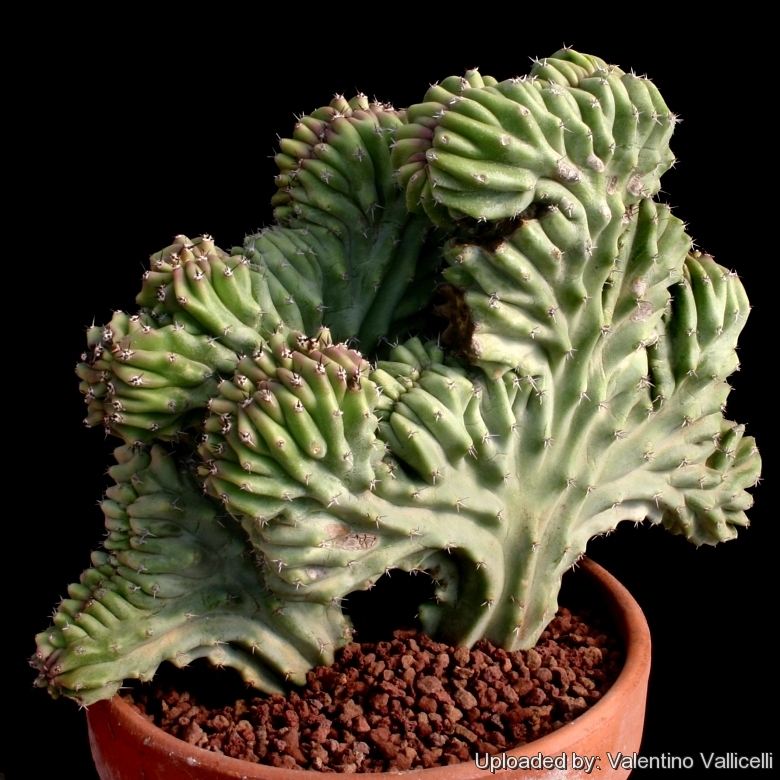
Pachycereus schottii f. cristatus Photo by: Valentino Vallicelli
Origin and Habitat: Garden origin (Nursery produced cultivar)
Synonyms:
See all synonyms of Pachycereus schottii
Description: The standard Lophocereus schotttii (Pachycereus) is a large, tree-like columnar cactus that grows to a height of 3-10 m tall that develops a sturdy trunk and with time can produce numerous arm-like branches. The beautiful crested form is very rare in collection and highly priced for its sculptural shape. Older crested plant grown outdoor in the ground (in mild areas) can reach an imposing size (up to 3 m tall and in diameter, or more ).
Remarks: There are indeed other crested clones of Lophocereus schotti that have a tendency to fan out, some will form stable crests while others just cluster over one another.
Subspecies, varieties, forms and cultivars of plants belonging to the Pachycereus schottii group
 Pachycereus schottii (Engelm.) D.R.Hunt: (var. schottii ) has relatively thick stems with fewer (5-6) stem ribs, and and trunk-less habit with numerous, ascending, columnar stems in a candelabra-like arrangement. Distribution: northern part of the range (southwestern Arizona to the Guaymas region and inland to Hermosillo, also Baja California to northern Baja California Sur.)
Pachycereus schottii (Engelm.) D.R.Hunt: (var. schottii ) has relatively thick stems with fewer (5-6) stem ribs, and and trunk-less habit with numerous, ascending, columnar stems in a candelabra-like arrangement. Distribution: northern part of the range (southwestern Arizona to the Guaymas region and inland to Hermosillo, also Baja California to northern Baja California Sur.)  Pachycereus schottii f. cristatus: This is a highly priced crested form for its sculptural shape. There are indeed other crested clones that have a tendency to fan out, some will form stable crests while others just cluster over one another.
Pachycereus schottii f. cristatus: This is a highly priced crested form for its sculptural shape. There are indeed other crested clones that have a tendency to fan out, some will form stable crests while others just cluster over one another. Pachycereus schottii f. mieckleyanus (Weing.) P.V.Heath: This monstros form has thinner stems with less tubercles. Stems are ascending but not straight with irregular bumps, slim, lightly pruinose, and also branch just from the base and occasionally at higher levels
Pachycereus schottii f. mieckleyanus (Weing.) P.V.Heath: This monstros form has thinner stems with less tubercles. Stems are ascending but not straight with irregular bumps, slim, lightly pruinose, and also branch just from the base and occasionally at higher levels Pachycereus schottii f. monstrosus (H.E.Gates) P.V.Heath: Mutation with variable, irregularly shaped ribs with raised, tubercle-like, knobby-looking swellings along the stems, and few (if any) spines or bristles.
Pachycereus schottii f. monstrosus (H.E.Gates) P.V.Heath: Mutation with variable, irregularly shaped ribs with raised, tubercle-like, knobby-looking swellings along the stems, and few (if any) spines or bristles.- Pachycereus schottii var. tenuis (G.E.Linds.) P.V.Heath: usually forms a short trunk, has more slender stems with 6-10 ribs, and is shrub sized. Distribution: Sonora, northwestern Sinaloa, and Baja California Sur.
 Pachycereus schottii cv. Big Penis Cactus: is a controversial monstrous cactus species with smooth rib-less stems, dubiously thought of as a mutant Lophocereus schottii and remembering of a large-sized Echinopsis bridgesii f. monstruosa (Long joined type).
Pachycereus schottii cv. Big Penis Cactus: is a controversial monstrous cactus species with smooth rib-less stems, dubiously thought of as a mutant Lophocereus schottii and remembering of a large-sized Echinopsis bridgesii f. monstruosa (Long joined type).
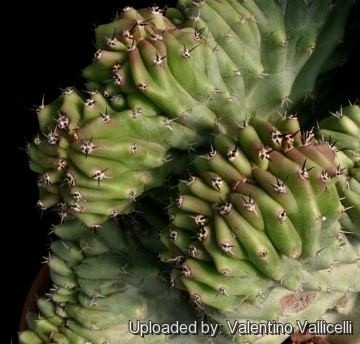 Pachycereus schottii f. cristatus Photo by: Valentino Vallicelli
Pachycereus schottii f. cristatus Photo by: Valentino Vallicelli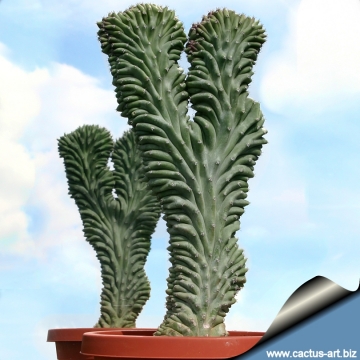 Pachycereus schottii f. cristatus Photo by: Cactus Art
Pachycereus schottii f. cristatus Photo by: Cactus Art Pachycereus schottii f. cristatus Photo by: Valentino Vallicelli
Pachycereus schottii f. cristatus Photo by: Valentino Vallicelli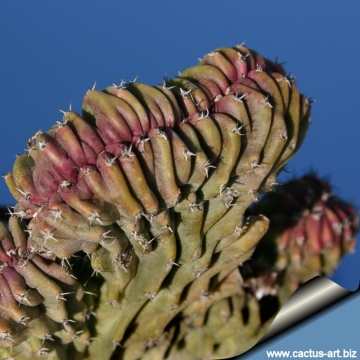 Pachycereus schottii f. cristatus Photo by: Cactus Art
Pachycereus schottii f. cristatus Photo by: Cactus Art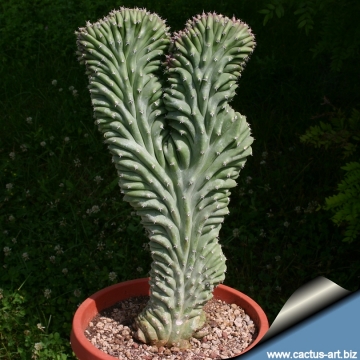 Pachycereus schottii f. cristatus Photo by: Cactus Art
Pachycereus schottii f. cristatus Photo by: Cactus Art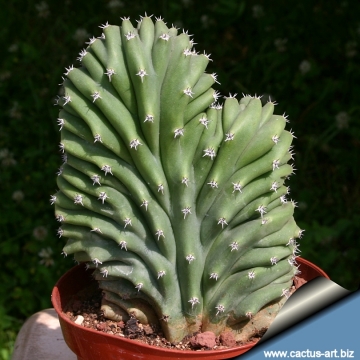 Pachycereus schottii f. cristatus Photo by: Cactus Art
Pachycereus schottii f. cristatus Photo by: Cactus Art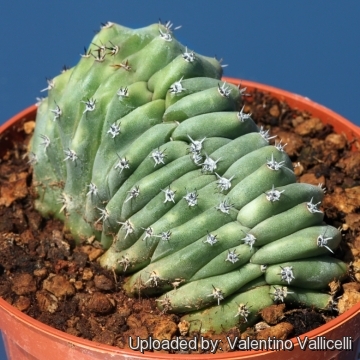 Pachycereus schottii f. cristatus Photo by: Valentino Vallicelli
Pachycereus schottii f. cristatus Photo by: Valentino Vallicelli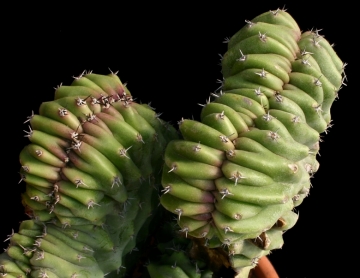 Pachycereus schottii f. cristatus Photo by: Cactus Art
Pachycereus schottii f. cristatus Photo by: Cactus ArtCultivation and Propagation: This species presents no problems in cultivation and will do well in a sunny spot in a cactus house. These plants will tolerate sun and heat, but not extended periods of frost. The crested form is more frost sensitive and should not be kept at less than 0° C. Grow them in rich, porous, sandy soil, and let their soil dry out between watering. If potted, repot in the spring, if their roots become cramped. Generally, they should be repotted every other year in order to provide fresh soil. However, this doesn't necessarily mean they'll need larger containers. Fill about a quarter of the pot with broken crocks, gravel, etc. to promote good drainage. After repotting, do not water for a week or more. The crested plants enjoy a warm sunny environment and for more speedy growth a light position on a higher shelf with light feeding and rainwater given to the bottom of the plant will ensure success, especially with rooted detached branches, which do well in these conditions.
Propagation: The crests are frequently grafted onto a Myrtillocactus geometrizansSN|8050]]SN|8050]] trunk, but are easily grown on their own roots. Any normal shoots should be removed to promote the growth of the crest. It can be increased by cuttings, which will take root in a minimum temperature of 20° C. Cuttings of healthy shoots can be taken in the spring and summer, Cut the stem with a sharp, sterile knife, leave the cutting in a warm, dry place for a week or weeks (depending on how thick the cutting is) until a callus forms over the wound. Once the callus forms, the cutting may be inserted in a container filled with firmed cactus potting mix topped with a surface layer of coarse grit. They should be placed in the coarse grit only; this prevents the cut end from becoming too wet and allows the roots to penetrate the rich compost underneath. The cuttings should root in 2 to 6 weeks.
Your Photos
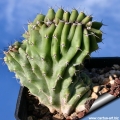
by Cactus Art



















